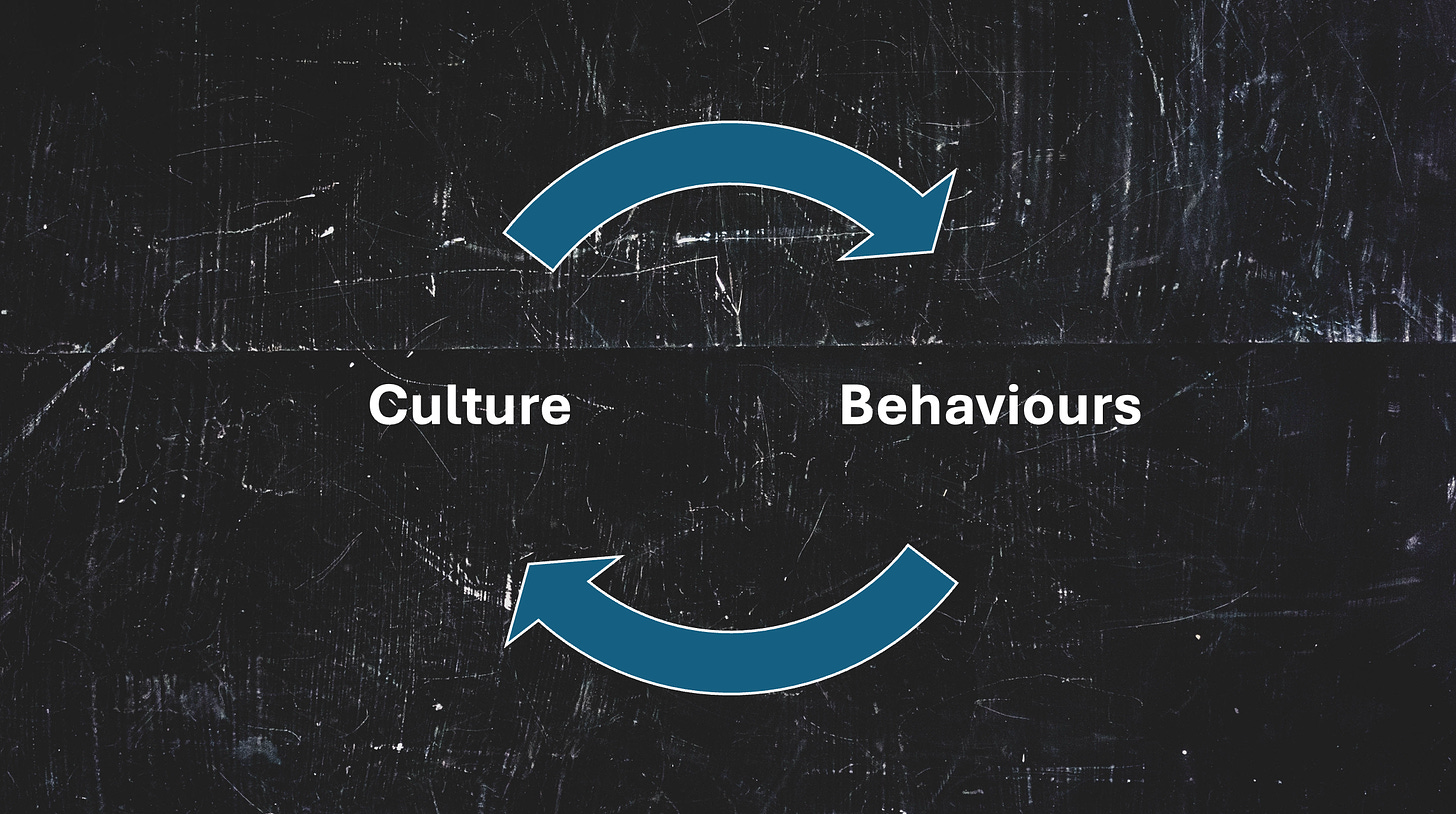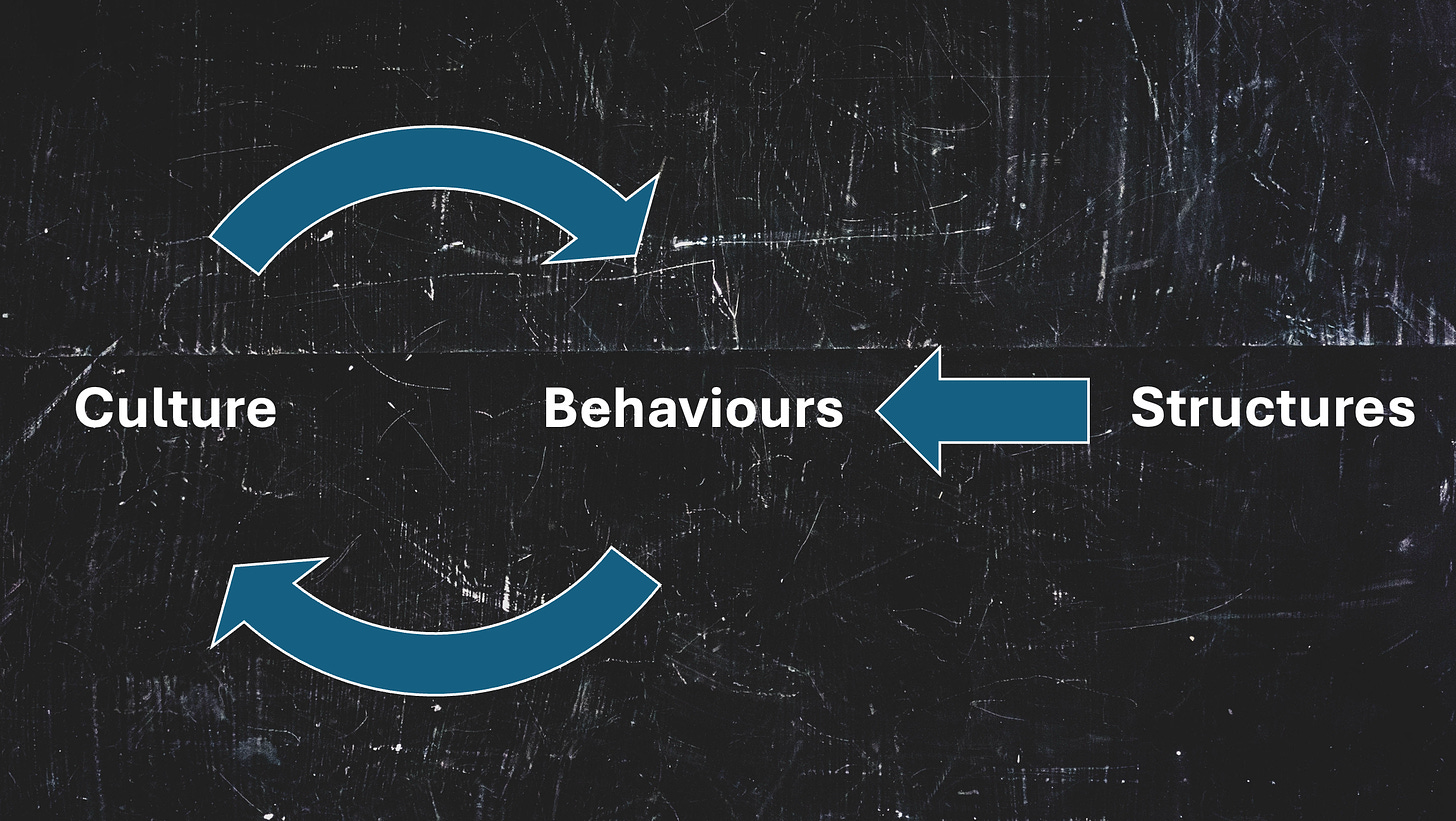Great structures, great performance
The obvious advantage of having better functioning systems within your organisation is that they reduce waste. When things 'just work', more of the energy that people put into their jobs gets transformed into the stuff you care about.
This is a very obvious and direct way that having better functioning systems contributes to high performance. But there is another way that is less obvious and actually runs deeper.
Craig Larman's Fifth Law of Organizational Behavior is:
Culture follows structure
What does this mean and why is it relevant?
Culture is a term that comes with a lot of baggage. "Company culture" has overtones of being a luxury commodity, for well-funded Silicon Valley types. Bean bags, free beer, slogans painted on the wall. But this is nonsense. Culture is an emergent property from the behaviour of the people in your organisation. Culture is both shaped by people's behaviour, and is something that shapes that behaviour. Like this:
Because culture is an emergent property, you cannot act on it directly. To quote John Seddon:
"Attempting to change an organization’s culture is a folly, it always fails. Peoples’ behavior (the culture) is a product of the system; when you change the system peoples’ behavior changes."
This is in the same way that you cannot act directly on 'traffic'. Traffic is just what happens as a result of the behaviour of lots of road users. You also have limited ability to act directly on behaviours - people are free agents, and will act under their own initiative. But what you can do is change structures, which make certain behaviours more likely.
For instance, "sheer weight of traffic" motorway gridlock can be reduced by lowering the speed limit. Lower speed limits lead to fewer lane changes. Fewer lane changes leads to less congestion. Traffic improves.
It's not just posted speed limits that affect driver behaviour. Other more indirect structures have a significant influence too. The visual layout of the road is one. Roads that have a wide, clear verge lead to higher driving speeds than roads which have trees planted close to the edge. If you want to create a safer driving culture in your city, having more tree-lined roads is a way to do it.
Hence:
This is what we mean by 'culture follows structure'.
The reason why culture is important to high performance is because high performance (IE 'creating lots of value and impact') comes from everyone's behaviour. High performance is about '100 heads' rather than than '10 heads and 90 pairs of hands'. That is, it's about establishing behavioural norms where everyone is using their creativity to solve real customer problems, and hence to deliver more of your mission.
As in the traffic analogy, you can influence people's behaviour in your organisation through structural changes in more direct and more indirect ways.
Your more direct source of influence is through the structures around the work itself. How are you monitoring and managing progress and performance? Are you providing people with opportunities to learn and make low-risk mistakes?
But - to gather the threads together - your back office operational systems are your indirect source of influence.
Things like your progression framework, your approach to safeguarding, your policies for taking time off... these things that seem very boring, very everyday. Organisational admin. BUT: These are all ways that you can cue the sort of ways of thinking, feeling and acting that super-charge your organisation.
To put it more concretely: If you are saying to people "we trust you and we want you to use your initiative!", but your staff handbook adopts a tone that talks to people like unruly children, what do you think the overall effect is going to be?
Or if you say you value "transparency", but all your salary decisions are made behind closed doors in ad-hoc negotiations... will people adopt the behaviours that you want to see?
Getting your structures right is a crucial part of building the culture that you want to see, in order to achieve the ambitious goals you are aiming for. They are how you ‘walk the walk’ of the kind of organisation you want to be.





